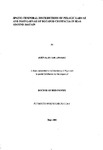SPATIO-TEMPORAL DISTRIBUTIONS OF PELAGIC LARVAE AND POST-LARVAE OF DECAPOD CRUSTACEA IN SEAS AROUND BRITAIN
| dc.contributor.author | LINDLEY, JOHN ALISTAIR | |
| dc.contributor.other | School of Biological and Marine Sciences | en_US |
| dc.date.accessioned | 2013-10-30T10:09:21Z | |
| dc.date.available | 2013-10-30T10:09:21Z | |
| dc.date.issued | 1998 | |
| dc.identifier | NOT AVAILABLE | en_US |
| dc.identifier.uri | http://hdl.handle.net/10026.1/2464 | |
| dc.description.abstract |
The geographical distributions and seasonal occurrences of decapod larvae and pelagic post-larvae in continuous plankton recorder (CPR) samples over a 3-year period were analysed and described. During this period, the survey covered large areas of the north-eastern Atlantic Ocean and adjacent continental shelf waters, including the English Channel and the North, Irish and Celtic Seas. Multivariate analysis provided the basis for classifying the distributions of 36 of the most abundant taxa (species, genera or subfamily) into groups. These groupings demonstrated the significance of bathymetry and temperature in limiting distributions. Larvae of 3 species were shown to disperse during development from areas where the earliest larvae occurred into areas that were presumably unsuitable for successful reproduction. Geographical variations in the seasonal timing of occurrence in the plankton of larvae of benthic decapods were correlated with parameters of temperature. Analysis of decapods from CPR samples in a subsequent anomalously warm year ( 1989) demonstrated that these correlations also applied to interannual variations within areas. Samples taken using the Longhurst-Hardy Plankton Recorder (LHPR) were analysed to describe vertical distributions of pelagic stages of decapods. Stratification of temperature, salinity and abundance of chlorophyll influenced the vertical distributions and die] migrations of decapod larvae. The nature and extent of that influence varied between taxa. For example Pagurus bernhardus zoeas were concentrated near the surface around the thermocline or below the thermocline according to conditions but Liocarcinus spp. zoeas were most abundant above or at the thermocline in all the profiles in which they occurred. Where ontogenetic variation was observed, later developmental stages generally occurred at greater depth than earlier stages. Some of the observed features of vertical distributions were consistent with aspects of results from the single depth CPR samples. The lengths of carapaces of specimens sorted live from the plankton were measured and dry weights, carbon content and nitrogen content of individual larvae were determined. Regressions of dry weight on carapace length, carbon weight on dry weight and nitrogen weight on dry weight were calculated and found to be comparable in most cases with published data on laboratory reared larvae. Regressions of development times on temperature for each stage of selected taxa with fixed numbers of developmental stages were derived from the literature. A method was developed for estimating biomass and production of planktonic larvae, including fluxes between the benthos and plankton at hatching and settlement, from the results of plankton surveys using the regressions of dry weight on carapace length and development times on temperature. Decapoda usually comprised 1-8% of the dry weight biomass of zooplankton retained by a 200µm mesh from samples in the Irish Sea and North Sea in the spring. | en_US |
| dc.language.iso | en | en_US |
| dc.publisher | University of Plymouth | en_US |
| dc.title | SPATIO-TEMPORAL DISTRIBUTIONS OF PELAGIC LARVAE AND POST-LARVAE OF DECAPOD CRUSTACEA IN SEAS AROUND BRITAIN | en_US |
| dc.type | Thesis | |
| plymouth.version | Full version | en_US |
| dc.identifier.doi | http://dx.doi.org/10.24382/4689 | |
| dc.identifier.doi | http://dx.doi.org/10.24382/4689 |
Files in this item
This item appears in the following Collection(s)
-
01 Research Theses Main Collection
Research Theses Main


